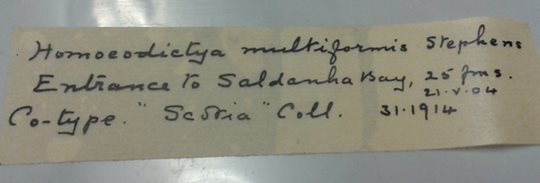Collected in 1904
Sponge from South Africa
This specimen of a sponge, Isodictya multiformis (Stephens, 1915), was collected by the Scottish National Antarctic expedition lead by Dr W.S. Bruce off the coast of South Africa in 1904.
By Leona McArdle
Specimen and register entry description
This specimen consists of a single sponge preserved in alcohol. It is approximately 11cm in length and 8cm in width, and is pale yellow in colour. The original name for this species was Homoeodictya multiformis but the taxonomy of this species has been updated in recent years. This specimen has been designated a “type specimen”, which is an organism that has been used to describe and name a new species, and so forms an important part of the museum’s scientific collection.
The zoological register describes the specimen as part of a larger donation, stating:
“Collection of sponges; Given by Dr W.S. Bruce; North & South Atlantic; Dredged by the Scottish National Antarctic Exp. 1902-04. Described by Jane Stephens in Trans. Roy. Soc. Edinb. Vol. 2. Pt. III 1914. The collection contains duplicate specimens of 26 spp. [species] (only 1 specimen having been obtained of the remaining 9 spp. given in the report) & includes co-types of 12 new spp. & slides (marked type) prepared from the 15 type specimens in Dr Bruce’s collection. The remaining specimens, including the types, returned to the Scottish Oceanographical Laboratory”
What are sponges?
Approximately 9000 species of sponge have been described worldwide to date, occurring at all depths and growing to a variety of shapes and sizes. Sponges are multicellular organisms in the phylum Porifera. They are sessile suspensions feeders and so they fulfil their food and gas exchange requirements by drawing water in through external pores (ostia), removing the nutrients and pushing the water (and waste products) back out of the body through larger pores (oscula). There are three types of body plan: asconoid, syconoid and leuconoid. The leuconoid level of organisation is typical of the Demosponge group, of which Isodictya multiformis is part and this is thought to be the most complex level of organisation. Isodictya multiformis is a member of the family Isodictyidae (Class Demospongiae), and is a marine species found most commonly around the coast of South Africa.
Why is this specimen in the museum?

This sponge was one of a number of specimens collected in the North and South Atlantic as part of the Scottish National Antarctic Expedition (SNAE) lead by Dr William Speirs Bruce to explore and perform scientific work in the Antarctic region from 1902 to 1904. W.S. Bruce was a 19th century naturalist and oceanographer, who launched the expedition from Troon, Scotland on the 2nd November 1902. The ship, the “Scotia”, travelled firstly to the Falkland Islands and then onto the South Orkney Islands to collect botanical and geological specimens. The expedition reached 700S before turning back to Laurie Island to spend the winter. Once the ice melted in November 1903 and supplies were restocked with a stopover in Buenos Aires, the expedition travelled south to the Weddell Sea and reached 740S before once again being forced to turn back due to ice. The successful crew returned to Scotland via Cape Town, South Africa and arrived in Scotland on the 21st July 1904. They brought with them a large collection of scientific specimens, with many species never before described.
This particular sponge was collected on the 21st May 1904 at a depth of 25 fathoms (150 feet, or 46 metres) in the entrance to Saldanha Bay, South Africa on the return leg of the journey, and was donated to the museum by Bruce in 1914. The sponge specimens from this expedition donated to the museum were described by Jane Stephens (1879-1959), a renowned expert in sponges and marine life and former member of staff in the National Museum of Ireland.
Learn more
This specimen is part of the Museum’s reserve collection and is not on public display. However, you can view other examples of sponges on display in the Irish Room of the National Museum of Ireland – Natural History. You can find out more about Jane Stephens in a previous “Documentation Discoveries” article.
References
Brusca, R.C. & Brusca, G.J. (1990). Invertebrates. Sinauer Associates, Sunderland.: [i]-xviii, 1-922.
Lucey, J. (2014). Jane Stephens (1879-1959): zoologist and leading authority on sponges. Irish Naturalists’ Journal 33: 93-99.
Mossman, R.C., Pirie, J.H.H. & Rudmose Brown, R.N. (1906). The Voyage of the Scotia: Being the Record of a Voyage of Exploration in Antarctic Seas. W. Blackwood & Sons, Edinburgh and London, pp. 527. (Available online at:https://archive.org/details/voyagescotiabei00brucgoog).
Stephens, Jane (1915). XV.—Atlantic Sponges collected by the Scottish National Antarctic Expedition. Transactions of the Royal Society of Edinburgh, 50, pp 423-467.
Location:
Sponge from South Africa is located at:
In Storage
Previous artefact:
Next artefact:
